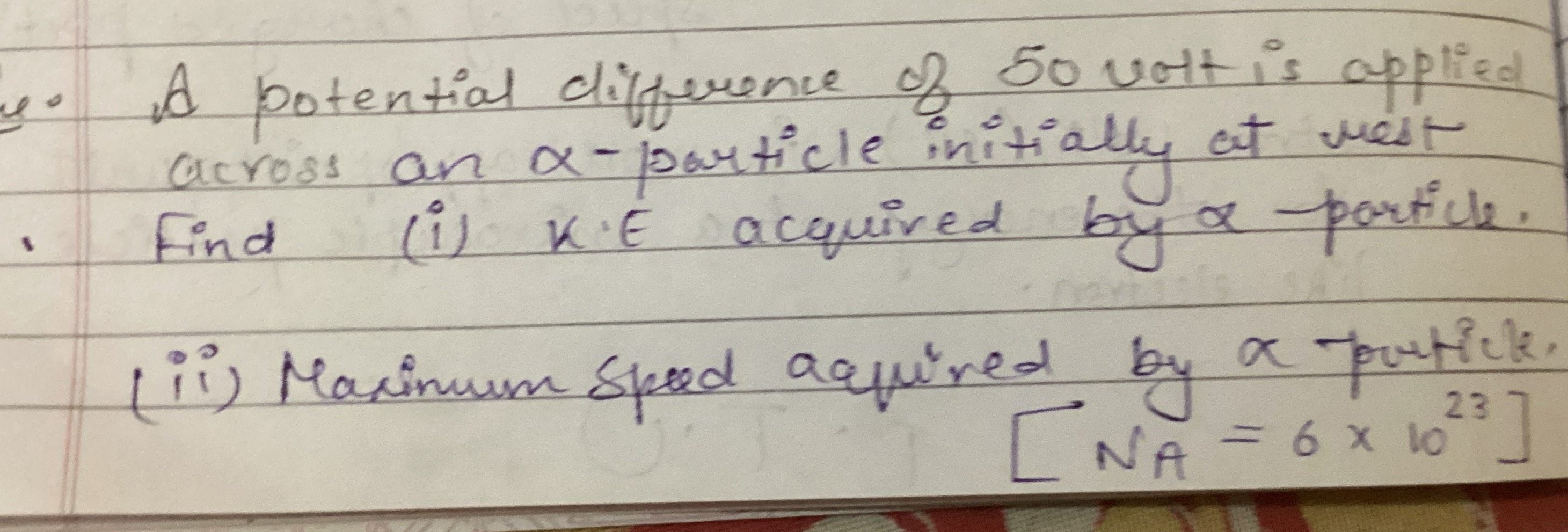Question
Question: A potential difference of 50 volt is applied across an $\alpha$-particle initially at rest Find (i)...
A potential difference of 50 volt is applied across an α-particle initially at rest
Find (i) K.E acquired by α particle.
(ii) Maximum speed acquired by α particle. [NA=6×1023]

K.E = 1.6×10−17 J, v = 6.94×104 m/s
Solution
Solution: An α-particle is a Helium nucleus, which has a charge of q=+2e, where e=1.6×10−19 C is the elementary charge. The mass of an α-particle is approximately m=4 amu. Using 1 amu=1.66×10−27 kg, the mass is m≈4×1.66×10−27 kg =6.64×10−27 kg. A more precise value for the mass of an alpha particle is 6.64465724×10−27 kg. We will use m≈6.64×10−27 kg for the calculation.
A potential difference of V=50 volts is applied across the α-particle initially at rest. The work done by the electric field on the α-particle is W=qV. According to the work-energy theorem, the work done is equal to the change in kinetic energy. Since the initial kinetic energy is zero, the kinetic energy acquired is equal to the work done.
(i) K.E acquired by α particle: K.E.=W=qV K.E.=(2e)×V K.E.=(2×1.6×10−19 C)×(50 V) K.E.=(3.2×10−19 C)×(50 V) K.E.=160×10−19 J K.E.=1.6×10−17 J
The kinetic energy can also be expressed in electron volts (eV): K.E.=qV=(2e)×(50 V)=100 eV. In Joules, 100 eV×(1.6×10−19 J/eV)=1.6×10−17 J.
(ii) Maximum speed acquired by α particle: The kinetic energy is related to the speed by the formula K.E.=21mv2, where m is the mass and v is the speed. 1.6×10−17 J=21×(6.64×10−27 kg)×v2 v2=6.64×10−27 kg2×1.6×10−17 J v2=6.64×10−273.2×10−17 m2/s2 v2=6.643.2×10−17−(−27) m2/s2 v2=6.643.2×1010 m2/s2 v2≈0.4819×1010 m2/s2 v2≈48.19×108 m2/s2 v=48.19×108 m/s v=48.19×104 m/s 48.19≈6.942 v≈6.942×104 m/s
Using a more precise mass m=6.64465724×10−27 kg: v2=6.64465724×10−273.2×10−17=6.644657243.2×1010≈0.48161×1010=48.161×108 v=48.161×104≈6.9405×104 m/s. Rounding to three significant figures, v≈6.94×104 m/s.
The final answer is K.E=1.6×10−17J,v=6.94×104m/s.
Explanation of the solution: (i) The kinetic energy acquired by the α-particle is equal to the work done by the electric field, which is given by K.E.=qV. Substitute the charge of the α-particle (q=+2e) and the potential difference (V=50 V) to calculate the kinetic energy in Joules. (ii) The kinetic energy is also related to the speed by the formula K.E.=21mv2. Use the calculated kinetic energy and the mass of the α-particle (m≈4 amu) to solve for the speed v.
Answer: (i) K.E acquired by α particle = 1.6×10−17 J (or 100 eV) (ii) Maximum speed acquired by α particle = 6.94×104 m/s
